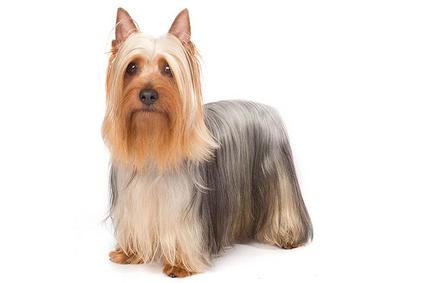History
The casual observer can be forgiven for mistaking a Silky for a Yorkshire or Australian terrier at first glance. After all, Yorkies and Aussies were the main components utilized by Australian breeders when creating the Silky in the early 20th century. Other breeds that might factor in the Silky’s development (depending on who’s telling the story) include Cairn, Dandie Dinmont, and Skye terriers, three of several British terriers brought to Australia by English settlers. For the record, Silkys are larger than Yorkies and smaller than Aussies.
About the Breed
A charming member of the AKC Toy Group, the compact, glossy-coated Silky Terrier is nonetheless a true terrier of energetic high spirits. The Silky, a native of Sydney, Australia, is larger than his close cousin, the Yorkshire Terrier.
Small but not fragile, feisty but not yappy, pretty but not sculpted, Silkys are 10-inch-tall dynamos animated by curiosity and high spirits. The glorious blue-and-tan coat is straight and glossy, and it feels and behaves much like human hair. The wedge-shaped head is topped by profuse hair parted down the middle, and erect V-shaped ears draw attention to the keen, piercing expression of the almond-shaped eyes. Silkys are more refined than typical ratting terriers, but they should still look and behave like a true earthdog.
Exercise
More a terrier than a lapdog, the Silky Terrier requires more exercise than most Toy Group breeds. Intelligent, bold, and energetic, Silkies need human partners who will know how to channel that energy into daily exercise and training for sports and work. The breed does well in the conformation ring, and Silkies have been successful in companion events, particularly agility.
Training
Silky Terriers can adapt well to any living situation but need owners who have the time to devote to them'¿they do not like to be ignored, preferring to play fetch or go on walks with their family. Taken by the breed's charm, owners may be tempted to let a Silky Terrier get away with undesirable behaviors; it's best to be sure to make rules and stick to them. The breed has a strong prey drive, and a leash is essential when walking outside.
Health
While Silky Terriers are generally healthy dogs, there are several health and genetic screening considerations specific to the breed. Responsible breeders test their stock for conditions the breed can be prone to, including patellar luxation and eye disease. A Silky Terrier's ears should be checked regularly for signs of infection, and the teeth should be brushed often, using a toothpaste designed for dogs. Regular visits to the vet for checkups and parasite control help to ensure the dog a long, healthy life.
Recommended Health Tests From the National Breed Club: No recommended health tests
Grooming
The Silky Terrier's coat should be brushed at least twice a week with a pin brush or soft bristle brush. A long-toothed metal dog comb can also come in handy for gently working through areas where tangles may be beginning to form. Left unattended, tangles and mats are uncomfortable for your dog and can cause skin problems to develop. The nails should be trimmed once a month, and a bath every four to six weeks with a gentle shampoo meant for dogs will help to keep the coat and skin clean and healthy. Grooming sessions are a good time to check the dog all over for any new lumps or skin problems, and to check that the eyes and ears are healthy and trouble free.
Sources: American Kennel Club
We All Have Our Favorites!
The Silky Terrier


